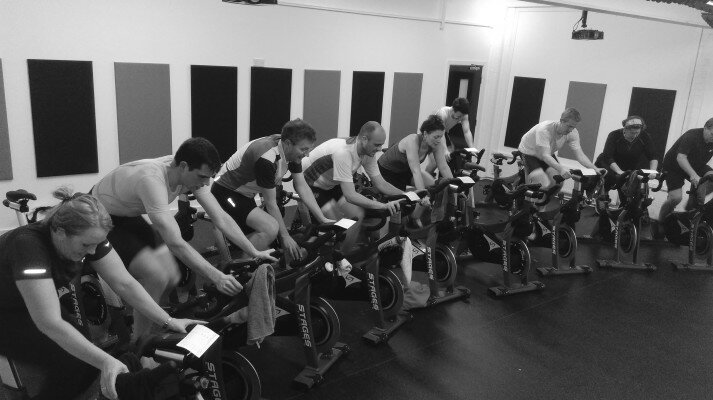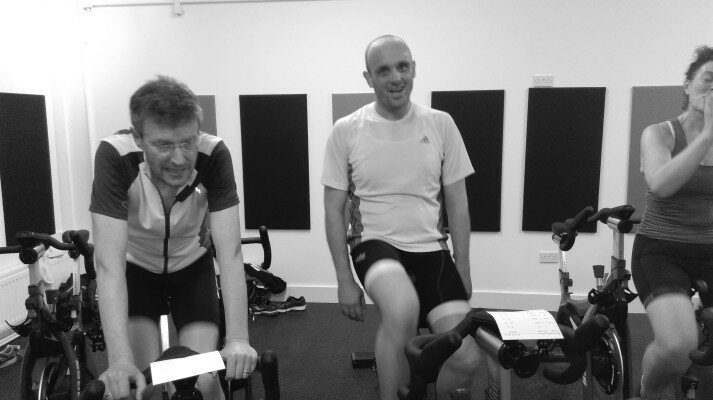For some people, riding a bike is a means to get fit. For others, fitness is a consequence of doing what you love.
Most of us probably sit somewhere on a line between the two that fluctuates depending on the favorability of time and weather. Much as we love Yorkshire cycling, even we have to admit that the Tour visited over a particularly great weekend and that there are cold, wet days and dark damp evenings in which we’d much rather be inside, albeit still on a bike.
Whatever your reason for wanting to improve your riding strength and fitness, short of having a personal trainer to chase on rides of ideal gradient and distance it is hard to argue with the benefits of well managed indoor training. Note the emphasis on ‘well managed’. Spinning your legs around on an exercise bike or turbo trainer with no real mission or consistency will likely yield minimal results and be terrifically boring. Alternatively, a traditional spinning class can be a fantastic cardio workout and great fun, but it won’t give you the targeted power gains you might want to be improving on, for example maintaining speed over short climbs or sustaining power up longer ones. The fitness industry is starting to take notice and last week we spent some time with Huw Spacey at the new Lear Fitness gym in Harrogate to learn a bit more about how training indoors with power can get us through the dull winter months and out the other side as stronger cyclists.
Huw has devised a training programme that utilizes the fleet of Stages indoor training bikes at Lear Fitness to deliver structured indoor cycling classes– an evolution on the standard gym bike you might be familiar with in that they also offer specific power measurement. We went along to a couple of their classes, first of all to have our Functional Threshold of Power (FTP) measured and then to take part in one of Huw’s structured interval sessions. Neither were easy, making me nostalgic for my school days when a lack of sporting prowess rendered me (and my total lack of effort) invisible to gym teachers. But they were a lot more fun than expected and we wouldn’t hesitate to recommend them to anyone that is serious about wanting to improve their fitness off the bike and make targeted gains on it.
Afterwards we sat down with Huw to learn some more about power training and classes that he is offering:
What is the difference between the training classes you offer and a conventional spinning lesson?
The classes that I am running use Stages Indoor cycles equipped with power meters.
The fact that the instruction is based on training zones means that it is specific to that individual, regardless of ability or experience on a bike. The use of power meters by cyclists on the road is just one use, we are using them to coach non-cyclists too and target specific areas of their physiology using specific workouts that are proven to work. This is quite different to a ‘spin’ class where everything is done on feel.
I like to start with a client by doing a Function Threshold of Power test with them in order to determine their current level, spot areas that we can be working on and most importantly, set their training zones to work on during my sessions. I can usually spot troublesome areas with their technique, often attributed to feet, hips or core strength and because I work closely with Lear Fitness’ Physiotherapist and Pilates instructor Elise Mailloux we can address those areas swiftly for the client, thereby helping them further with their physiology and cycling technique.
Giving each client their own specific training zones means that I can have the least experienced cyclist and Bradley Wiggins in the same class, and they will both get the same quality of workout at the same intensity. That leads to a good atmosphere in the classes as everyone is doing the same thing at their own specific output.
And why is power so important rather than using a heart rate monitor for training?
This is a really big question, and one that is asked regularly now that power meters are being used by so many people, but something that requires breaking down into several components. Bear with me here…
The main benefit of a power meter is that you can measure your efforts and gauge them without question. A power meter is measuring the users output from the bike. If you are performing interval training and want to be sure that you’re hitting the correct zones, then a power meter is the way to go. Having already performed a ‘test’ with me, we can figure out your limits and training zones which allows you to pace yourself efficiently during efforts.
A heart rate monitor is measuring your body’s input to the bike. There will be a lag response time between your output and your HR rising to its target zone. A power meter is particularly useful during shorter intervals (under a couple minutes) when your HR spends much of the interval rising to the zone you’re targeting. You’ll very likely be going too hard at first when trying to get your HR up, and then the rest of the interval you’ll be so tired out you’ll actually be pushing very little power (but your HR will remain high). When you use a power meter, you’ll notice that when you push a specific wattage it will feel easy at first, but as the interval progresses it will begin to feel harder, yet the power will remain constant and HR will rise. As your form progresses, you’ll notice that you’ll be able to push a higher wattage at a certain heart rate. This is when you know your training is working.
Heart rate monitors are good intensity-measuring devices also. But heart rate by itself actually doesn’t tell you much. It’s like the rev counter on a car—it tells you how hard the engine is working but nothing more. Data such as heart rate isn’t meaningful until it is compared with some measure of output. Output is critical to success, input isn’t. After all, they don’t give awards at races to those who worked the hardest or had the highest heart rates (input), but rather to those who had the fastest time which results from high power (output).
Then we have heart rate drift – another topic in itself. Your heart rate can be incredibly variable and be affected by several factors including temperature, illness and fatigue but power doesn’t lie.
All that said, a power meter is only effective if you are using it in conjunction with a prescribed training plan or session from a coach, or instructor who knows what he’s doing with power. That’s my job, I design the workouts to get the best from you, using a bit of periodisation and specificity.
A lot of people get pleasure from a normal spinning class comes from the motivation of working in time to the music – what do you do to push people through the toughest efforts?
I do use upbeat music in my classes but my main motivation is vocal and encouraging the clients to target a wattage specific to the effort that we are doing at that time. For longer efforts, say 2 minutes or more, I try to describe a setting; perhaps a hill they know with other riders, or racers on encouraging them to keep with the wheel in front of them playing on the imagery that we have all seen on the television during the Tour De France. I am hoping to utilize the projectors in the room soon and have some alpine climbs or stages from big well known bike races on the wall. I know that type of imagery would help motivate me and so I am sure it would help others also.
So do you feel that having numbers to focus on adds an extra layer of motivation as well as purpose?
Having a number to chase, or hang on to definitely helps to motivate you, that feeling of seeing your wattage slide during an effort drives you on push it back up again. Without that interface you don’t really know you are slowing down until it’s too late.
How do you make sure that classes appeal to both the committed rider as well as someone who might want to attend one of your classes for purely fitness reasons?
I have many clients that are not serious or experienced cyclists and come to the classes for the fitness benefit. The style and efficiency of the sessions lend themselves to everyone wanting to better themselves. Many of the classes I run are great fat burning sessions, as well improving lactate threshold which to an experienced cyclist is the Grail, but it applies to everybody. The more efficiently your body can deal with lactate build up, the better your fitness becomes and the longer you can go, on or off the bike. It is all about improving the cardio-vascular system and the efficiency of delivering oxygen to the muscles. I have some clients that do different sports like squash and use the classes to improve their top end without the high impact that other ‘cross training’ activities might bring.
For anyone that can’t make it to one of your classes, what one piece of advice would you give them to keep their fitness up over the winter?
Interval training, Interval training, Interval training, and some long rides. Eat well, stave off illness by eating the right foods to keep your immune response high and recover well in between workouts. That and do something that makes you happy at least once a week.
To learn more about Huw’s indoor power classes, contact the Lear Fitness gym in Harrogate on 01423 709 844 or email [email protected]


